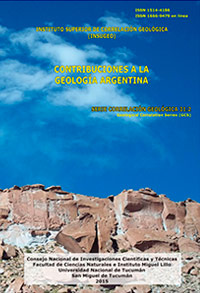Serie Correlación Geológica 31 (2)
Estudio preliminar de la evolución geomorfológica del abanico aluvial de Lima (Perú) e implicancias en el análisis de amenazas asociadas al cambio climático
Sandra P. Villacorta | Trinidad De Torres | Cosme R. Pérez Puig | Miguel Llorente | Luis Ayala
Descargar trabajo en formato PDFResumen
ESTUDIO PRELIMINAR DE LA EVOLUCIÓN GEOMORFOLÓGICA DEL ABANICO ALUVIAL DE LIMA (PERÚ) E IMPLICANCIAS EN EL ANÁLISIS DE AMENAZAS ASOCIADAS AL CAMBIO CLIMÁTICO. La ciudad de Lima, ubicada en la costa central de Perú, es la capital y ciudad con una mayor población, por encima de los 9 millones de habitantes. Lima se ubica en el margen de dos placas tectónicas: la de Nazca y la Sudamericana. Una gran parte de la ciudad está construida sobre los sedimentos no consolidados del abanico aluvial del río Rímac. Estas características geológicas y geomorfológicas confieren una alta amenaza por terremotos devastadores y tsunamis, que pueden acarrear una subsecuente pérdida de vidas humanas. Por tanto, es de vital importancia comprender adecuadamente el origen y la dinámica geológica del abanico aluvial de Lima, con el objetivo de permitir y asegurar el desarrollo de planes de gestión de riesgo adecuados. En tal sentido, un estudio exhaustivo se viene desarrollando para recolectar y analizar la información que podrá ser utilizada para comprender cómo se desarrollarán los eventos geo-hidrológicos futuros en el área de Lima y cómo se verán afectados por los cambios climáticos (deglaciación) o tectonismo. En este artículo se presenta una iniciativa conjunta del Instituto Geológico, Minero y Metalúrgico (INGEMMET) en convenio con el Instituto Geológico y Minero de España (IGME) y la Universidad Politécnica de Madrid (UPM), para la investigación de estos fenómenos, en la búsqueda de promover en el Perú las investigaciones sobre paleo-inundaciones. Los avances realizados hasta la fecha son el análisis de la información disponible y generación de la cartografía geomorfológica preliminar, básicamente de terrazas fluviales, que han permitido dilucidar hipótesis sobre la evolución del abanico y proyectar las siguientes investigaciones. Las formas de relieve cartografiadas dan cuenta de que las condiciones de precipitación en el pasado eran mayores. La fuerte antropización del espacio (densa red vial, concentración y expansión urbana), explicaría los procesos de desbordamiento y la dinámica de los flujos.
Abstract
PRELIMINARY STUDY OF THE GEOMORPHOLOGICAL EVOLUTION OF THE ALLUVIAL FAN OF LIMA (PERU) AND IT´S IMPLICATIONS FOR HAZARDS ASSOCIATED WITH CLIMATE CHANGE. Lima, located on the central coast of Peru, is the capital and largest city with a population of more than 9 million inhabitants. Lima is situated over the boundary of two tectonic plates: Nazca and South American plates. A large portion of the city is constructed over the unconsolidated sediments of the Rimac River alluvial fan. These geological and geomorphological features make the area a high risk zone related to devastating earthquakes and tsunamis and the subsequent possible loss of life. Therefore, it is vitally important that the origin and geological dynamics of Lima’s alluvial fan are fully understood to enable and ensure the development of workable risk management plans. In this way, a significant investigation is being conducted to collect and analyse information that can be used to understand how future geo-hydrological events may take place and how these events will be affected by climate changes (deglaciation resulting in isostatic rebound and/or eustatic adjustment) or tectonism. This project is a joint initiative between the Geological, Mining and Metallurgical Institute (INGEMMET, the Peruvian Geological Survey) in partnership with the Geological Survey of Spain (IGME) and the Polytechnic University ofMadrid (UPM) to investigate these phenomena and promote the research on paleo-floods on Peru. This paper presents the initial analysis of available information and the generation of preliminary geomorphological mapping, mainly of fluvial terraces, that allowed elucidation of hypotheses on the evolution of the fan and project future investigations to carry out. Geoforms show that previous rainfalls were bigger than today. The great anthropization of the area (dense road network, urban concentration and sprawl) should explain the flooding processes and flow dynamics.






